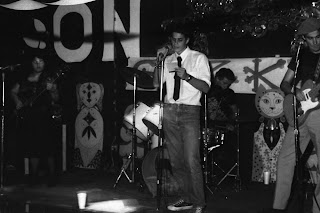Add Helios Creed to the list of musicians who have bypassed the standard way of getting a label to release their music. With the release of Half Machine From the Sun, his approach of taking the case directly to fans and using their donated funds in order to get this collection of Chrome demos from the late 1970's through early 1980's has been proven very effective. Disaster Amnesiac was one of the online donors, and as such, was updated often during Creed's lengthy process of mixing and mastering these 18 tunes for release. I noted that he achieved his monetary goal pretty rapidly. Others noted the sometimes frustrating amount of time between the initial offering and the release, but, thankfully, it's been worth the wait.
All of Half Machine's tracks stick to the standard Chrome format: solid beats are laid down, on top of which treble-ey guitar and electronic sounds ride, then either augmented by Damon Edge's Romantic Goth tenor voice or samples from some Noir film. This format is one that Chrome fans love, and Disaster Amnesiac is definitely a Chrome fan. Said beats are simple, crisp, and played on what surely sounds like an old, beat up, kit. I have an abiding love for these kinds of kits (off-brand, cracked cymbals, old heads,etc.), so a lot of my enjoyment of this recording comes from listening to the funky sounds coaxed from the drums; they remind this listener of Jamaican Dub or primal motorik beats of the prime era Krautrock bands. Creed's guitar playing is cutting and incisive on tunes such as Looking For Your Door With All Seeing Eye, almost Industrial. On Sunset he unleashes six string squalls that sound like updates and refinements of the Hendrix sound. Edge's vocals range from really freaked on Fukushima (Nagasaki) to an almost Bryan Ferry-like suave on The Rain. The entire affair exudes a great post-Punk trippy sound, one evocative of the clammy night and fog of their S.F. hometown, perhaps laced with speed and acid edges as the electronics peal and oscillate. Many a Post Punk band would have wished they could have gotten down with such ease as on Sub Machine or Autobahn Brazil.
Do seek out these burnished new/old sounds from one of San Francisco's finest purveyors of Experimental Rock, the Mighty Chrome.
UPDATE: Disaster Amnesiac was mistaken a few times here, as it's actually Helios that sings on Fukushima (Nagasaki) and The Rain. An honest mistake, and, man, Creed sounds so different here than on his solo LP's!








